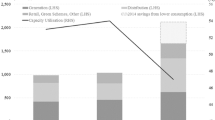Abstract
A utility’s profit-maximizing level of investment in energy efficiency or demand-side management (DSM) programs and mix of programs is affected by natural load growth, the frequency of rate cases, program costs, and the structure of any mechanism designed to either compensate the utility for foregone profits or sever the link between sales and profits. Under a range of reasonable assumptions, decoupling can incent a utility to invest in DSM. However, a utility experiencing high natural load growth and little inflation is likely to resist the imposition of a decoupling mechanism, as it would tend to lower profits. A utility with low growth in per-customer sales will tend to favor decoupling, as it will tend to lead to higher profits than under traditional regulation. The results presented here are quite sensitive to the assumptions made regarding natural load growth, regulatory lag, the frequency of price changes, price elasticity of demand, and other factors. This suggests that there is not a single approach to promoting energy efficiency without penalizing utility profits that will work in all situations for all utilities.




Similar content being viewed by others
Notes
Of course, non-economic motives may be considered in addition to the economic benefits and costs considered here. These may include customer service goals and corporate sustainability commitments.
The GAMS code used in this analysis is available from the author upon request.
Efforts to permit demand to adjust to contemporaneous price changes resulted in convergence problems. Consequently, a lagged response is modeled here.
A wide range of long-term price elasticities are reported in the literature. Espey and Espey (2004) report a range from −2.25 to −0.04.
Attempts to explicitly model federal income taxes as a function of profits (and, thus, implicitly, a function of all other variables in the model) resulted in convergence problems. These problems persisted even when rates were set so as to include taxes paid in the previous year. Provided that profits remain positive and the tax rate is a fixed percentage of profits, after-tax profits will be proportional to pre-tax profits. And optimization based on pre-tax profits should yield the same result as optimization based on after-tax profits.
Because utility investments in infrastructure can have very long accounting lives and the model presented here examines only a 10-year planning horizon, some of the results presented here may be understated.
References
Anderson, J. (2007). ELCON opposes utility revenue decoupling as a device to open doors to energy efficiency. Platts Power Markets Week. March 2.
Averch, H., & Johnson, L. (1962). Behavior of the firm under regulatory constraint. American Economic Review, 52, 1052–1069.
Brennan, T. (2010). Decoupling in electric utilities. Journal of Regulatory Economics, 38, 49–69.
California Public Utilities Commission and California Energy Commission. (2001). California standard practice manual: Economic analysis of demand-side programs and projects. San Francisco: California Public Utilities Commission and California Energy Commission.
Cappers, P., Goldman, C., Chait, M., Edgar, G., Schlegel, J., Shirley, W. (2009). Financial analysis of incentive mechanisms to promote energy efficiency: Case study of a prototypical southwest utility. LBNL-1598E. March.
Edison Foundation. (2011). State electric efficiency regulatory frameworks. Washington, DC: Edison Foundation.
Espey, J., & Espey, M. (2004). Turning on the lights: A meta-analysis of residential electricity demand elasticities. Journal of Agricultural and Applied Economics, 36(1), 65–81.
Eto, J., Stoft, S., & Belden, T. (1997). The theory and practice of decoupling utility revenues from sales. Utilities Policy, 6(1), 43–55.
Hirst, E., Blank, E., & Moskovitz, D. (1994). Alternative ways to decouple electric utility revenues from sales. The Electricity Journal, 7, 54–66.
Kihm, S. (2009). When revenue decoupling will work. . . and when it won't. Electricity Journal, 22(8), 19–28.
Kushler, M., York, D., & Witte, P. (2006). Aligning utility interests with energy efficiency objectives: A review of recent efforts at decoupling and performance incentives. Report no. U061. Washington, DC: American Council for an Energy Efficient Economy.
Moskovitz, D., Harrington, C., & Austin, T. (1992). Weighing decoupling vs. lost revenues: Regulatory considerations. The Electricity Journal, 5, 58–63.
National Association of Regulatory Utility Commissioners. (2007). Decoupling for electric and gas utilities: Frequently asked questions. Washington, DC: National Association of Regulatory Utility Commissioners.
Tempchin, R. (1993). Decoupling? Not so fast. The Electricity Journal, 6, 2.
U.S. Environmental Protection Agency. (2007). National Action Plan for Energy Efficiency. Aligning utility incentives with investment in energy efficiency (p. ES-3). Washington, DC: U.S. Environmental Protection Agency.
Weston, F. (2008). Customer-sited resources and utility profits: Aligning incentives with public policy goals. US EPA Webinar presentation. Regulatory Assistance Project.
Acknowledgments
The author benefited from earlier exchanges with C.K. Woo and I. Horowitz on this topic. Michele Chait, Parviz Adib, and George Mentrup provided valuable comments on earlier versions. Three referees provided exceptionally detailed and invaluable suggestions on the initial submission, resulting in significant improvements to this paper.
Author information
Authors and Affiliations
Corresponding author
Rights and permissions
About this article
Cite this article
Zarnikau, J. The many factors that affect the success of regulatory mechanisms designed to foster investments in energy efficiency. Energy Efficiency 5, 393–410 (2012). https://doi.org/10.1007/s12053-011-9139-1
Received:
Accepted:
Published:
Issue Date:
DOI: https://doi.org/10.1007/s12053-011-9139-1




